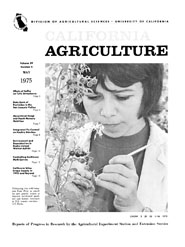


University of California
California Agriculture
|
|||
|
|||

Cover:
Pollinating tiny wild tomatoes from Peru in search for new genetic strains to improve nutritional qualities and disease resistance in US. tomato varieties - U.C. Davis.
May 1975
Volume 29, Number 5 |
|||
|
University of California, 1301 S. 46th St., Bldg. 478 Richmond, CA
|